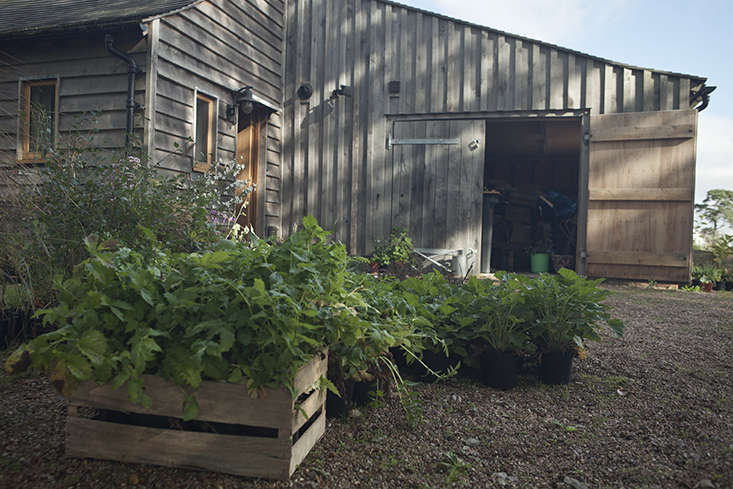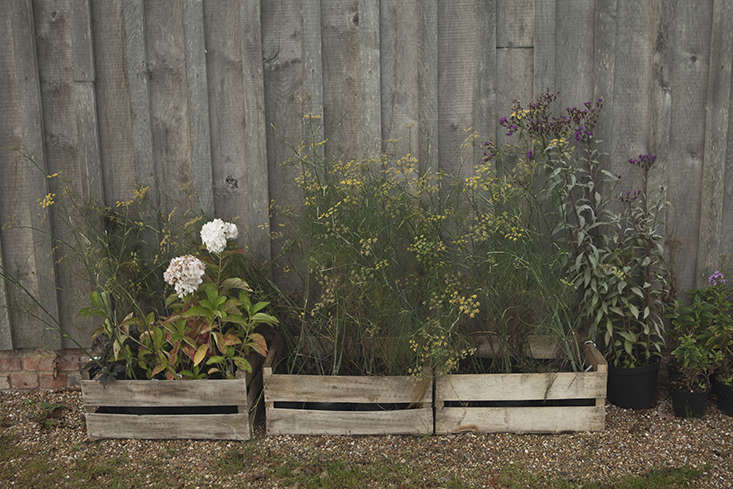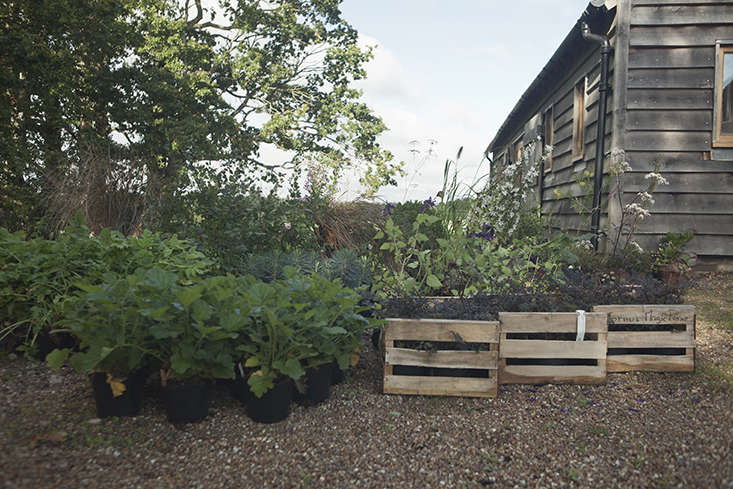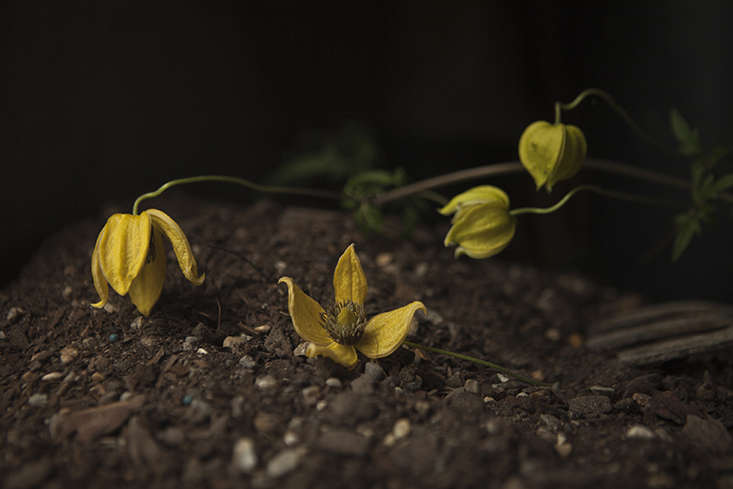James Horner is a Sussex-based floral designer whose work regularly takes him to London, Tuscany, and the Balearic Islands. With no greenhouse or permanent garden, his ideas percolate in boxes gathered around his rented house near Great Dixter, where he spent his formative years.
Photography by Jim Powell for Gardenista.
Above: Outside the garage and front door.
James’s perennials are regularly taken to London, as part of his commitment with the Rosewood Hotel. He also brings his plantsmanship to the gardens of Italian designer Luciano Giubbilei. The two met at Great Dixter, where James had taken up the first Christopher Lloyd Scholarship. This involved living in the medieval manor and working closely with visionary head gardener Fergus Garrett for one year. He stayed on for a couple more and during that time Luciano showed up, looking to refresh his personal contact with plants, after years at the drawing board.
Above: Dark foliage of Anthriscus sylvestris ‘Ravenswing’ fill crates in the driveway.
On winning Best in Show at Chelsea in 2014, Luciano Giubbilei was quick to acknowledge that the magic touch had come from his residency in the intensely creative atmosphere of Great Dixter. Garden critics were impressed by the joyous planting, with memorably sunny yellow lupines at the flowery end. The planting was carried out by James, representing the Great Dixter element.
Above: Asters, grasses, and sanguisorba in the portable garden.
James rents part of a derelict walled garden an hour from home. This is where he can experiment, examining plants as they grow, in groups or individually.
Above: James’ plants grow hard, outdoors, preparing them for life beyond his daily care. Just as soil is the foundation for a good garden, so the soil composition in each individual pot is crucial to a plant’s success. “Plants are easily lost in winter by growing them too soft, in rich and crude potting soil,” James explains. “Or from sitting in excessively wet soil.” He creates his own soil mix, based on what he learned at Dixter and adapting it to the type of plant he is potting. James’s own mix is a concoction of processed bark, loam, gravel, compost made from garden waste, plus John Innes Compost. He also adds Osmocote plant food.
Above: The seed table. Let James explain: “I sow seeds into a one-centimeter (just less than half an inch) layer of find sand, and then apply a protective layer of grit. The amount of grit depends on the size of the seed; for instance Nicotiana seed should be sown onto the gravel so as not to be lost beneath it. Same for poppies.
“The sand retains moisture and the grit warms up in the sun. The rest of the pot is my soil mix.”
Above: Dahlia ‘Café au Lait’ waiting in the cool dark of the garage. A makeshift potting table and work space has been made from a board laid across plastic refuse bins.
Above: Dried flowers have a granny-ish image for people (like me) who grew up in the 70s. Younger folk like James are free of these preconceived ideas and he uses dried flowers in arrangements without apology. They are, after all, an extended version of prairie planting, except that instead of keeping them in situ all winter they are brought indoors. Ingredients for this potential dried bunch are: Sanguisorba ‘Henk Gerritsen’, greater quaking grass Briza maxima and white Anaphalis.
Above: A fresh arrangement on the garage floor, made up from the pale ‘Café au Lait’ dahlia, yellow Clematis tangutica, tall white Francoa ramosa, New England aster ‘Kylie’, and potato vine (Solanum laxum ‘Coldham’).
Above: An orderly collection by the house. At James’s walled garden, things are perhaps less easy to navigate, with everything bunched together. “I need to go back to regimented rows, so that things are easily accessible,” says James. “I’d like to be able to dig out or pick what I need more easily.” This is a project for the coming winter.
Above: Cold frames, put together with OSB board (similar to particle board) and tongue-and-groove. “They come in handy in winter,” says James. Lids could be attached, to keep plants on the dry side. “Brick cold frames are much better as they absorb warmth, reflecting any heat,” he advises.
Above: Clematis tangutica ‘Bill MacKenzie’ (and some of James’ potting mix), in the garage.
For more, see Required Reading: Meadows at Great Dixter and Beyond and 10 Easy Pieces: Essentials of the English Garden.























Have a Question or Comment About This Post?
Join the conversation (2)